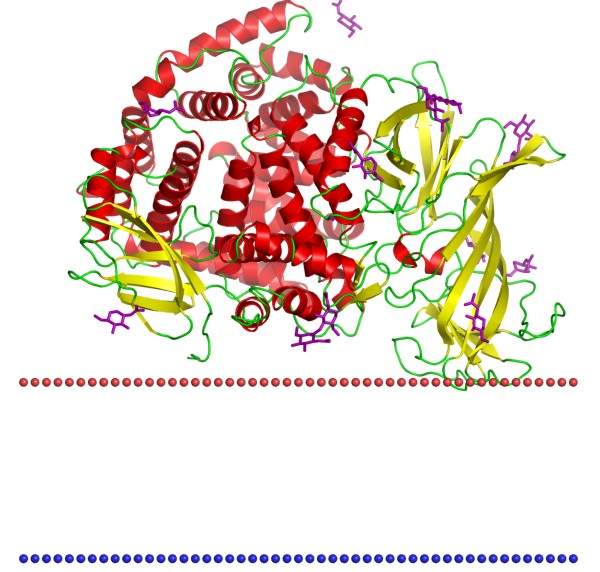Mempro™ Peptidase MA Production Using Virus-Like Particles
Creative Biostructure can provide unmatched custom Mempro™ peptidase MA production services based on virus-like particles system.
Up to now, over fifty metallopeptidase families have been identified. Depending on the number of metal ions required for the catalysis, metallopeptidases can be divided into two classes: one class recruits only one metal ion for catalysis, while the other class, termed peptidase MA, needs to coordinate two metal ions. Peptidase MA superfamily belongs to a group of metallopeptidases that are hydrolases, of which the enzymatic mechanism is a divalent cation (usually zinc but may be cobalt, manganese or copper) activating the water molecule through the nucleophilic attack on a peptide bond. Peptidase MA is one of the two zinc-dependent metallopeptidases, containing the HEXXH motif with the two His residues as zinc ligands.

Figure 1. The schematic structure of Leucyl-cystinyl aminopeptidase. (OPM Database)
Virus-like particles (VLPs) can mimic the native virus, however, which are non-infectious due to lack of any viral genetic materials. It has been well known that VLPs are self-assembled multiprotein structures. VLPs can be obtained from the Hepatitis B virus and are composed of the small HBV derived surface antigen (HBsAg). Recently, virus-like particles carrying conformationally-complex membrane proteins (termed lipoparticles) have been applied for integral membrane protein production. Lipoparticles can incorporate a wide range of structurally intact membrane proteins, including G protein-coupled receptors (GPCRs), ion channels.
Creative Biostructure provides high-yield peptidase MA in the stable, highly purified and native-conformation state. Lipoparticles can be produced from bacterial cells, yeast cells, insect cells, plant cells and mammalian cells for peptidase MA production. Escherichia coli (E. coli) strains and insect cells are the most commonly used systems for VLPs production. Mammalian cells are also widely used for VLPs production with the target to construct vaccine candidates and gene therapy agents. For instance, we can obtain lipoparticles from mammalian cells by co-expressing the retroviral structural core polyprotein, Gag, along with a desired membrane protein. Gag core proteins self-assemble at the plasma membrane, where they bud off and capture target membrane proteins. Since the peptidase MA superfamily proteins within lipoparticles are derived directly from the cell surface without mechanical disruption or detergents, the native structure and orientation of membrane proteins are retained.
Creative Biostructure can also provide other various Mempro™ membrane protein production services. Please feel free to contact us for a detailed quote.
References:
A. Roldão, et al. (2010). Virus-like particles in vaccine development. Expert Rev. Vaccines, 9(10): 1149-1176.
M. Gaczynska, et al. (1994). Peptidase activities of proteasomes are differentially regulated by the major histocompatibility complex-encoded genes for LMP2 and LMP7. Proc. Nat. Acad. Sci. U. S. A., 91(20): 9213-9217.
S. Willis, et al. (2008). Virus-like particles as quantitative probes of membrane protein interactions. Biochemistry, 47(27): 6988-6890.